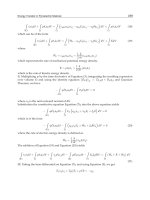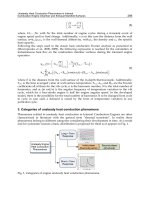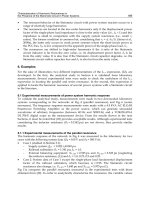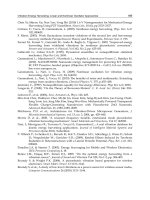Build A Remote-Controlled Robot part 11 ppt
Bạn đang xem bản rút gọn của tài liệu. Xem và tải ngay bản đầy đủ của tài liệu tại đây (114.36 KB, 10 trang )
container (a former milk container) and passes it via a tube
(fish tank air tubing) to an outlet on the underside of the
robot’s wrist below the control button. This way the person
getting the drink can control the amount dispensed.
Questor’s head consists of a 12-volt automobile dome light
and a cube shaped cover made of opaque ceiling light panels.
The head’s cover is the most delicate part of Questor and
should be fabricated, fitted, and then removed until the
68 CHAPTER FIVE
TABLE 5-1. Parts List
AMOUNT ITEM
1 Pushbutton SPST switch
1 12-volt dc pump
1 1-gallon milk container and cap
1 8-foot ϫ 2-inch PVC piping
4 2-inch-diameter PVC end-cap
2 2-inch-diameter PVC elbow
1 9 1/2- ϫ 9 1/2- ϫ 1/8-inch sheet of hardboard
4 1-inch ϫ 1/4-inch-diameter nut, bolt, and
lockwasher set
1 1- ϫ 2-foot section of sheet metal
6 1/4-inch-diameter washer
1 4-foot-length fish tank air tubing
2 Auto drink holder
1 Tube of silicone glue
1 1-slot fuse holder
1 12-volt auto dome light with switch
1 2- ϫ 4-foot sheet of ceiling light panel
6 1/8-inch ϫ 1/8-inch-diameter sheet-metal screw
# Miscellaneous wood screws
1 2-post barrier strip
# Rolls of 18-gauge wire, red and black
4 2- ϫ 2-inch corner brace
4 1-inch ϫ 1/8-inch-diamter bolt, nut, and
lockwasher set
robot’s final assembly to protect it from damage. The head
lights when a button (that should come with the auto dome
light kit) mounted on the robot is pushed. Questor’s head
serves two functions: One, as an attention getter, being that
the light is quite bright and, two, to illuminate the objects
being carried on his serving tray, The serving tray will be
mounted at the same time as Questor’s head, during final
assembly. The following sections will detail the construction
and installation of the robot’s arms, drink dispenser, and head.
ARMS
Questor’s arms are very simple to make and install; however,
care should be taken when fabricating them because errors in
the parts may affect the way the arms are mounted and how
level the serving tray sits on the arms. After viewing pictures
of Questor earlier in this book, the way the arms look and
their position should be rather obvious.
The arms are made from 2-inch-diameter PVC piping used
for plumbing (or robot arms). You will need two 8-inch and two
21-inch lengths of PVC. When you buy the PVC, also purchase
two 90-degree turn elbows and four end-caps. Figure 5-2 shows
what these parts look like.
When you cut the PVC piping, be sure to make your cuts as
straight as possible; I suggest you use a miter box to ensure
straight cuts. Cut the lengths of PVC according to Fig. 5-3 and
assemble them, as well as the elbows and end-caps, together
according to the figure. Be sure that the elbows and end-caps
fit snugly on the tubing because you will not be gluing or fas-
tening the parts together.
Once assembled, check to see that the arms are the same
height and length. Do this by standing them next to each other.
If the arms are not correct, all that may be needed is some tap-
ping or pulling of the end-caps so that they fit more snugly or
closer to the PVC pipe, or stick out farther from it. If the devi-
ation is large, you should disassemble the arm and recut a new
section of PVC piping. The piping is usually sold in eight-foot
ARMS AND SUBSYSTEMS 69
lengths, so you should have plenty if this occurs. After you
have the arms assembled, take a marker and draw a ring
around the pipes tracing the ends of the elbows and end-caps.
These lines will act as a guide, so if you disassemble the arms
for cutting and drilling, they can be reassembled correctly.
Now take one of the arms and hold it up against the side
of Questor’s upper framework so that the top edge and lower
arm lines up with the two 1/4-inch-diameter predrilled holes
on the framework as shown in Fig. 5-4. Mark where the holes
meet the elbow and arm and drill two 1/4-inch-diameter holes
where marked. Do the same with the other arm. Before the
arms can be bolted to the framework, a 3/8-inch hole must be
drilled on the outside of the lower part of the arm. Figure 5-5
70 CHAPTER FIVE
FIGURE 5-2. Elbow and end-cap.
ARMS AND SUBSYSTEMS 71
FIGURE 5-3. Arm assembly.
FIGURE 5-4. Mounting holes for the arm.
shows the location of this hole. The hole which lines up to the
1/4-inch-diameter hole drilled previously is used to access the
head of the bolt so you can turn it with a screwdriver when
attaching the arm to the framework.
Three more holes must now be drilled in Questor’s left
arm to accommodate parts used in the drink dispenser. One of
the two 1/4-inch-diameter holes is drilled along the inside of
the lower section of the arm and allows a tube from the drink
dispenser to pass into the arm. The second 1/4-inch-diameter
hole is drilled on the underside of the arm just behind the
front end-cap. This hole is where the outlet spout of the dis-
penser is located. The final hole drilled in the arm is located
directly above the hole for the outlet spout on the top of the
arm behind the end-cap; it allows wires for the control button
that switches the drink dispenser on and off to reach the switch
that will be mounted in the end-cap. The hole’s diameter
depends on the type of switch you have obtained. Figure 5-6
shows where the three holes are drilled on the left arm.
After all the holes have been drilled, there is one final
preparation to be made. Two small squares must be cut from
the ends of the two upper pipes of the arms. These cutouts
allow for the pipes to be refitted to the elbows once the bolts
are in place. Make sure these cutouts are bigger than the head
of the bolts you use. Refer to Fig. 5-7 for the location.
The arms can now be reassembled and bolted to the
framework. Starting with the lower portion of the arm, reat-
tach it to the elbow, then aligning the hole on the elbow once
72 CHAPTER FIVE
FIGURE 5-5. A 3/8-inch-diameter access hole.
ARMS AND SUBSYSTEMS 73
FIGURE 5-6. Holes in the left arm for the drink dispenser.
FIGURE 5-7. Bolt head clearance cutouts.
again with that on the frame, bolt it in place using a 1-inch ϫ
1/4-inch-diameter bolt, nut, and lockwasher set. Do the same
with the mounting hole on the lower arm, only stack three
washers between the arm and the framework so the arm sits
straight along the framework. You can access the head of the
screw through the 3/8-inch holes drilled on the sides of the
arm. Now you can replace the upper section of the arm being
sure to align the small cutout section on the piece with the
head of the bolt holding the elbow to the framework. Figure 5-8
shows how the arms are mounted to the framework.
The last component that completes Questor’s arms are his
hands. The hands are simply two auto drink holders mounted
to the end-caps on the front of Questor’s arms. The top of the
drink holder is removed and the rest is screwed to the end-cap
with a 1/8-inch screw. Figure 5-9 shows a completed hand.
After you have made the hands, set them aside; they will be
attached to the robot’s arms later during the robot’s final
assembly. You are now ready to build Questor’s drink dispenser
and install it in the robot’s left hand.
74 CHAPTER FIVE
FIGURE 5-8. Arm mounting.
DRINK DISPENSER
Figure 5-10 shows the parts layout for Questor’s drink dis-
penser. The dispenser’s base, on which all of the components
are mounted, consists of a 9 1/2- ϫ 9 1/2-inch piece of 1/8-
inch plywood. The unit, when completed, is mounted in
Questor’s upper framework, hence the 9 1/2- ϫ 9 1/2-inch
base. As you can see by the previous figure, many parts for the
dispenser must be modified or fabricated before they are
mounted; the first of these is the 12-volt pump itself.
The pump (listed in parts list; your pump could be different)
has two large input/output spouts that have to be removed so
that the remaining parts of the spout can accept the narrower
tubing used to pass fluids through the system. Figure 5-11
shows what portion of the spout to remove. Next, two sheet
metal brackets need to be cut; these brackets hold the drink dis-
penser’s tank, a 1-gallon milk container, in place and prevent it
ARMS AND SUBSYSTEMS 75
FIGURE 5-9. Completed hand.
from shifting when the robot moves. The template for those
brackets is shown in Fig. 5-12. Lastly, the cap to the 1-gallon
milk container must have two holes made in it. The first hole,
located in the center of the cap, is for the input tube going to
the pump that draws fluid out of the container. A second small-
er hole is made next to that one so air can get into the container
when fluid is being drawn out. Otherwise, a vacuum would
form inside the container, causing it to collapse.
After the parts are prepared, they can be mounted on the
base as shown in Fig. 5-10. Start with the brackets that hold
76 CHAPTER FIVE
FIGURE 5-10. Drink dispenser layout.
the 1-gallon milk container in position. Place the container on the
base and press the metal brackets around it; the metal will bend
to the shape of the container. Now mark the location of the
brackets mounting tabs, remove the container, and screw
the brackets in place using four 1/8-inch wood screws.
Next is the pump which is mounted in the right rear corner
of the base. It too is held in place by 1/8-inch wood screws.
Near the pump on the back edge of the base, mount the barrier
strip and fuse holder; make sure to allow about an inch
ARMS AND SUBSYSTEMS 77
FIGURE 5-11. Remove these sections from spout.
FIGURE 5-12. Template for drink tank brackets.









